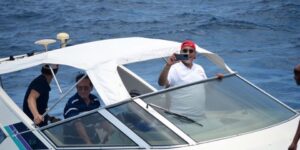Five minutes into our journey, we hit what felt like bumps and potholes, except that we were not on land. My heart dropped to my stomach. We were in the deep sea, with no land in sight, on a boat that crested the gigantic waves like a bus climbing up and down a hill.
And even though the coxswain had warned us about this, nothing prepared me for the feeling. It was a mix of excitement and fear. I was excited because we were on our way to see one of the biggest animals on earth — the humpback whale.
For me, it was a one-in-a million chance, but here I was wondering what I would do if the vessel capsized. In what direction would I even swim?
“We are now at a boiling pot. Here, two ocean currents meet and the sea is usually rough,” shouted Mr Alfred Kenga, the coxswain, as the vessel moved up and down, and side to side — as if somebody was shaking a small tree.
Whale migration
It was around 10am, but the sun had just escaped from the sky as if to give us space to proceed on our journey to what seemed like nowhere.
Since its inception two years ago, the watching of the annual humpback whale migration in Watamu, Kilifi County, has become one of the biggest tourism attractions in the country.
Its timing, coinciding with the wildebeest migration in the Maasai Mara National Reserve, gives tourists a unique holiday experience this time of year.
Tourists are used to watching dolphins and hundreds of fish species at the Watamu and Kwale marine parks, which are found in shallow waters, but for whale-watching, one has to journey past the reef, to the deep sea.

Last Friday, Tourism CS Najib Balala, together with top government officials, joined tourists to witness the spectacle in Watamu. The Nation team was in the expedition to the Malindi/ Watamu National Marine Reserve, which started at the Hemingways resort.
“Be prepared for a lifetime experience. Just like a safari in the countryside, this journey will be bumpy and hilly bearing in mind the situation of the sea,” Mr Kenga had said as we set off.
Magical moment
“I have spotted one there!’ shouted one of the tour guides, pointing to a spot in the sea where water spurted like a fountain.
There was joy as everyone tried to capture the magical moment. It was a mother whale and her calf, and within a short time, the place was swarming with other vessels, which approached the area so tourists could watch the two as they swam, flapping their huge fins.
Humpbacks are known as the most acrobatic among the whale species as they spend a lot of their time leaping from the water, showing off their huge bodies while they play or remove parasites. Mother and calf did not disappoint!
“There are over 200 of them each year. Around July to September they usually migrate from Antarctica to warmer climates and congregate in Kenyan waters where they mate and calve,” said Ms Jane Silbury, a marine conservationist working with the Watamu Marine Association, which has been studying the whales for years. “The whale watching has a global income of over USD2 billion a year.”
Earlier, we had spotted a group of dolphins and turtles gently floating on the water before diving into the ocean.
Kilifi Governor Amason Kingi said the humpback whale migration was the perfect opportunity for the county to showcase to the world the diversity it offers in hospitality and tourism.
Credit: Source link